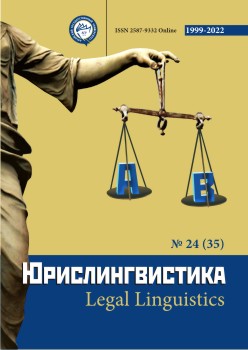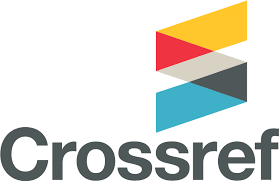On Сommercial Names Forming a Single Semantic Construction in Forensic Linguistic Examination
Abstract
The work discusses the problem of forensic linguistic examination of a trademark, as well as the search for ways to optimize this procedure. Unresolved issues arising during the examination of a trademark are discussed. It is shown that one of the most difficult cases of such expertise is the analysis of similarity to the extent of mixing one-word trademarks and compound ones. A complicating factor in the study of such naming units is the ability of a composite designation to form an integral structure (an integral combination). In practice, it is quite problematic to make a decision on the perception of a composite designation as a whole. That is why this article aims to find criteria on the basis of which an expert linguist could unambiguously identify a combination of words as a whole. For this purpose, the classification of a phrase according to the degree of connectivity of its components (division into syntactically free (articulate) and syntactically non-free (integral, non-articulate) combinations) is discussed and various approaches to understanding the integral composite designation are generalized. Special attention to phraseological units and synlexes as the main types of integral word combination is paid. The language markers of the word combination are discussed. In particular, it is shown that in order to formulate conclusions about the integrity of word combination, a positive answer to the question: "Does the meaning of the studied word combination look like a meaning of separate word?" is needed. Also negative answers to such questions as: "Do the words forming the studied combination retain an independent meaning?"; "Does each of the words bring meaningful information into understanding the general meaning of the combination?"; "Can the elements of the studied word combination be replaced by other elements?" are needed. Using the example of a specific linguistic expertise, the methodology for determining the linguistic markers of a whole word combination is demonstrated and thus specific ways of objectifying the results of linguistic expert examination of trademarks are proposed.
Downloads
Metrics
References
Бакич (Самыличева) Н.А. Трансформация прецедентных феноменов в медийном тексте как проявление речевой креативности / Вестник Нижегородского государственного университета им. Н.И. Лобачевского. – Сер. Филология. – 2018. – № 5. – С. 185–190.
Большой толковый словарь русского языка / под ред. С.А. Кузнецова. СПб., 2000.
Дударева Я.А. Методика определения ассоциативного сходства товарных знаков: пропозициональный анализ / Вестник Кемеровского государственного университета. – Кемерово, 2012. – №1. – С. 143–148.
Каменская О.Г., Кан Р.А. Современный русский язык. Ч. 3. Синтаксис. Тольятти, 2012.
Климовская Г. И. Дело о синлексах (К вопросу о функциональном подходе к номинативному материалу языка) / Вестник Томского государственного университета. – Сер. Филология. – 2008. – № 3 (4). – С. 44–54.
Курганова Е.Б. Игровой аспект в современном рекламном тексте. Воронеж, 2004.
Лингвистический энциклопедический словарь / под ред. В.Н. Ярцевой. М., 1990.
Не следует разделять элементы товарного знака на сильные и слабые, если в сознании потребителя это единое целое. URL: http://ipcmagazine.ru/news/5935-news4520.
Новичихина М.Е. О некоторых трудных случаях лингвистической экспертизы товарных знаков / Вестник Воронежского государственного университета. – Сер. Филология. Журналистика. – 2012. – № 1. – С. 221–227.
Новичихина М.Е. О нерешенных вопросах и перспективах лингвистической экспертизы товарных знаков / Вестник Воронежского государственного университета. – Сер. Филология. Журналистика. – 2019. – № 1. – С. 127–129.
Пипченко Н.М. Современный русский язык: Синтаксис словосочетания и простого предложения. Минск, 2008.
Руководство по осуществлению административных процедур и действий в рамках предоставления государственной услуги по государственной регистрации товарного знака, знака обслуживания, коллективного знака и выдаче свидетельств на товарный знак, знак обслуживания, коллективный знак, их дубликатов (утв. приказом Роспатента от 24июля 2018г., №128). URL: https://rulaws.ru/acts/Rekomendatsii-po-osuschestvleniyu-administrativnyh-protsedur-i-deystviy-v-ramkah-predostavleniya-gosudarst-solt-bucjeeid/.
Синтаксис современного русского языка / под ред. С.В. Вяткиной. СПб., 2009.
Стернин И.А. Основы лингвокриминалистики. Воронеж, 2018.
Цой Е.В. Адвербиальный синлекс и свободное словосочетание в обстоятельственной функции / Филологические науки. Вопросы теории и практики. – 2013. – № 5 (23). – С. 211–213.
Copyright (c) 2022 Марина Новичихина

This work is licensed under a Creative Commons Attribution 4.0 International License.
The authors, which are published in this journal, agree to the following conditions:
1. Authors retain the copyright to the work and transfer to the journal the right of the first publication along with the work, at the same time licensing it under the terms of the Creative Commons Attribution License, which allows others to distribute this work with the obligatory indication of the authorship of this work and a link to the original publication in this journal .
2. The authors retain the right to enter into separate, additional contractual agreements for the non-exclusive distribution of the version of the work published by this journal (for example, to place it in the university depository or to publish it in a book), with reference to the original publication in this journal.
3. Authors are allowed to post their work on the Internet (for example, in a university repository or on their personal website) before and during the review process of this journal, as this may lead to a productive discussion, as well as more links to this published work (See The Effect of Open Access).










